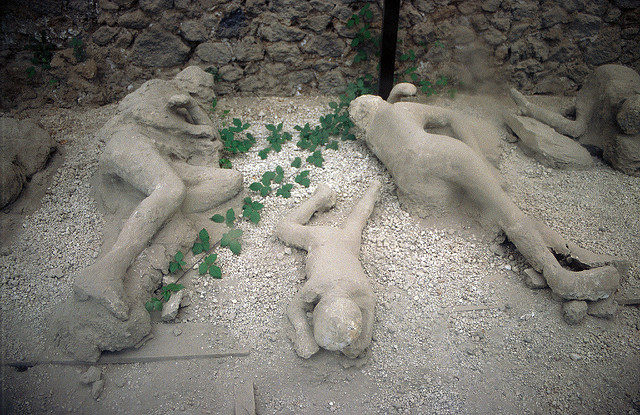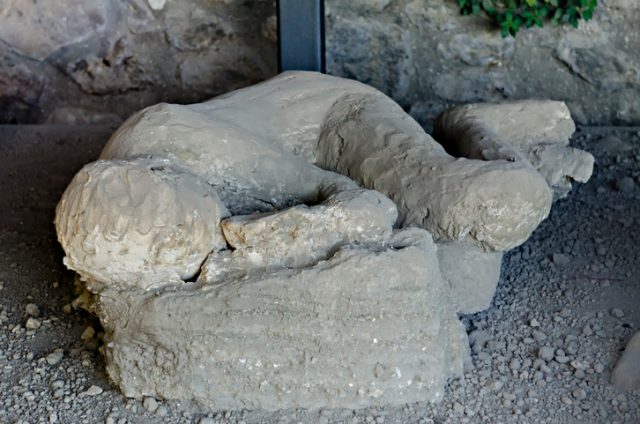Are these the remains of a master and servant from history’s most famous volcanic tragedy, Pompeii? Over the past 150-odd years some 1,500 souls have been found in the ash.
These 2 however are intriguing because they reveal more about day to day life in 1st century Italy.
Of course it was no ordinary day for the unfortunate pair when Mount Vesuvius erupted in AD 79. The cities of Pompeii and nearby Herculaneum realized nature could be a cruel mistress.

As chaos rained down, the men appear to have retreated to an underground chamber in a suburban villa. History.com notes: “Some 2,000 people stayed in Pompeii, holed up in cellars or stone structures, hoping to wait out the eruption.”
The general location is Civita Giuliana on the ruined city’s outskirts… not a place for the down at heel, though it makes sense the area contained more than a few slaves.
Remember it was so eery visiting Pompeii on a school trip and seeing the casts – this is also morbidly fascinating!
Pompeii dig reveals ‘almost perfect’ remains of a master and his slave https://t.co/D33fL2ihio
— Remona Aly (@RemonaAly) November 22, 2020
These latest grisly finds suggest that death came on the second day of the catastrophe, as Vesuvius delivered another wave of molten destruction.
Live Science reported late last month that they were discovered “side-by-side in an L shape, with one man’s feet nearly touching the other’s shoulders.”
Why do experts think it’s a master and his put-upon slave? The younger of the two, apparently aged between 18-25, has damage to his vertebrae consistent with gruelling tasks.

By comparison the older individual (thought to be 30 – 40) possesses “a stronger bone structure, particularly around his chest area”, as written by The Guardian. Not conclusive by any means but enough to draw some compelling conclusions.
The Guardian details the process undertaken by archaeologists. While their ancient remains are in excellent condition, the men turned to dust centuries ago.
Bones prove vital for analysis, yet ash is also surprisingly helpful. Scientists trained a laser on imprints left by the bones, performing a thorough scan.
Casts were also made using Pompeii’s natural, ready-made moulds for the plaster. It’s here an especially interesting element was spotted – fabric folds, indicating what the men were wearing. They both have tunics, though the older “master” is distinguished by a woollen cloak.
Quoted by Sky News, Pompeii Archaeological Park Director Massimo Osanna states the men “may have been seeking refuge”. Something of an understatement perhaps! And no wonder – as he goes on to say, via Reuters, they experienced “death by thermal shock”.

Far from a pleasant way to go. The chamber, a “cryptoporticus” (or corridor/passageway) according to Live Science, couldn’t keep out deadly clouds of super heated rock and gas. This can also be called a “pyroclastic flow”.
The Guardian describes their horrific fate, writing the flow would have “burned away all the soft tissues such as their skin and muscle.” The ash reached a depth of over 6 feet, meaning no escape for scalded citizens, no matter what their status.
On a grim but positive note for experts, “their bones and teeth were preserved.” Clenched feet and hands are signs of the agony they must have gone through. Other gaps in the ash seem to show evidence of cloth bundles. Things the men were carrying on their attempted escape from Vesuvius’s wrath?
History.com mentions the fatal irony of Pompeii. Although it was a successful hub for Romans, the fertility of the soil might have given residents a clue as to what lay in store. Black beneath their feet, it became that way through previous volcanic eruptions!
Civita Giuliana has proved a rewarding location for archaeologists, particularly in recent years. Live Science writes about excavations beginning again in 2017.
A move part-inspired by enthusiastic amateurs and light-fingered diggers looking to pocket some potential Pompeii profit.
Another Article From Us: Is This the Childhood Home of Jesus Christ, Archaeologists Believe So
It’s been known about since the 16th century but the intrigue of Pompeii shows little sign of going dormant. This magical and eerie place is still telling the world its story, one ash-coated body at a time…
